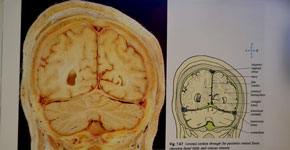A select few of TJ’s science students take a trip they won’t soon forget.

A picture of a human brain offers a sample of what students had the opportunity to examine during their cadaver lab. Photo by Becca Hansen.
On Monday, April 9th, 18 of TJ’s Anatomy and AP Biology students, accompanied by a UCD medical student, gathered at a Wheatridge hospital for a special lab in which the students had the opportunity to dissect and examine a donated cadaver.
Students were to meet in the lobby of Lutheran Medical Center no latter than 5:45 pm. Shortly after gathering, the students were briefed on ground rules of the lab and brought to the basement of the hospital to the lab room. Jane Stewart, a medical student from the University of Colorado at Denver, began taking the TJ students through the lab. “I thought the lab was a great learning experience to actually see everything in relation to the body instead of just in the textbook. I really liked our med student that took us through the lab. She had a really profound interest for what she was teaching, which made it a lot more interesting and memorable. She was also just fun, and made an effort to make the lab fun for us,” said Junior Morgan Cain.
The group started the lab by unzipping the bag enclosing the cadaver. They removed the heart, stomach, and lungs. “I thought it was really cool when we took the heart and the kidney’s out. Our cadaver was an older women with some serious left ventricle problems and enlarged kidneys,” said Junior Mike Mahoney.
As the group went through the different organs and systems in the body, their goal was to determine why she died. Due to confidentiality procedures the cadavers name and age were not revealed. “My favorite part of the lab was figuring out how she died, and it reminded me of CSI. She had a shrunken tongue and a feeding tube attached to her stomach. We determined she was in a coma when she died. We also saw that she had circulation problems that probably lead to the coma,” said Junior Jackson Epstein.
AP Biology teacher Scott Thomas has been to the lab several times before, and says each one is a different experience depending on the cadaver. “My favorite trip with this lab was three years ago. The cadaver was a man who had a knee replacement and a hip replacement in the same leg that we dissected out. I’ve seen the artificial parts before, but to actually see it in the body was pretty cool,” said Thomas.
In addition to the lab’s informative and educational nature, Thomas says he sends his students to go for the once in a lifetime opportunity. “I take my students to be able to participate in a unique experience. Very few people get the opportunity to see an actual cadaver and dissect it. I think it’s a very fun night for my students,” said Thomas.